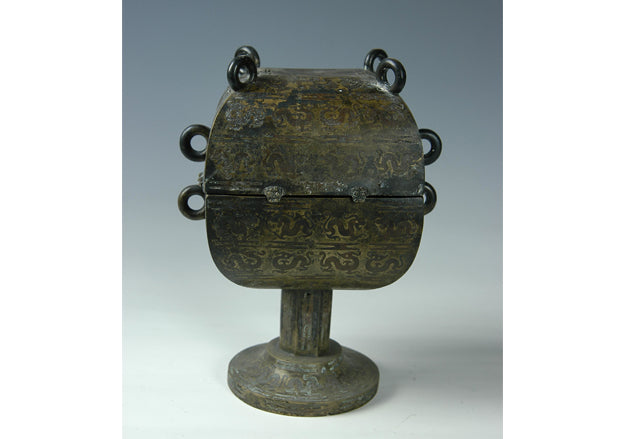
Cast copper dragon-patterned square bean

Square bean with red copper dragon pattern, bronze, Spring and Autumn Period. Total height 29.7 cm, diameter (including lid) 15.8 cm. Excavated from the burial pit of Tomb No. 1 in Hougudui, Gushi County, Henan Province in 1978. Now in the collection of Henan Museum.
Bean, the name of the vessel, was first seen in oracle bone inscriptions. Its shape is similar to the high-footed plate of later generations, with a plate-like belly, a round bottom, a long and thick handle under the belly, and a ring foot under the handle. It is divided into lidded and unlidded shapes, and the handle is also divided into solid handle and hollow handle. Copper beans originated from pottery beans of the same shape. Pottery beans first appeared in the Neolithic Age, and pottery beans were still common and popular in the Shang and Zhou Dynasties. Copper beans were first seen in the Shang Dynasty, were popular in the two Zhou Dynasties, and were popular from the late Spring and Autumn Period to the Warring States Period.
"Zhou Li Tianguan Meiren" records: "The Meiren, who is in charge of the four beans." This shows that beans should be containers for holding food.
The square bean bowl with cast and inlaid red copper dragon pattern[1] is in the shape of a lid with an open mouth. The bowl is in the shape of a square bucket with a gradually narrowing belly. There is an octagonal high-handled columnar bean handle at the bottom, a double-basin-shaped ring foot base at the bottom, and a square lid on top. There are symmetrical ring ears on both sides of the body and lid, and ring buttons on the four corners of the lid top, which can be turned upside down to form a vessel. Except for the ears and buttons that are welded, the body, lid and ring foot are decorated with cast and inlaid red copper dragon patterns. The dragon patterns are symmetrical in pairs, with angry eyes facing each other, heads raised, belly arched, tails raised and feet spread out, which are vivid and lifelike, full of dynamics. The bottom of the bean bowl and the inside of the lid are engraved with the inscription: "(Similar) Drink".




![8.3"China Shang Dynasty,Bronze wine cup [Fuhao Jue cup][妇好爵杯]](http://bronzc.com/cdn/shop/files/4ee0482982cfa89bb4d1cff3333a55e6_e3ca0b86-22fc-497d-9afd-578c551225a3-2.jpg?v=1733986652&width=533)

![12.8" China Ming Dynasty, Phoenix-patterned bronze vase[Ming Wanli Phoenix-patterned vase][明万历凤纹瓶]](http://bronzc.com/cdn/shop/files/4ee0482982cfa89bb4d1cff3333a55e6_a516991b-2bb9-4b2f-a2b6-4354129d006c.jpg?v=1733986953&width=533)

![14.6" China Eastern Han Dynasty Bronze vessel in the shape of a flying horse,Also known as bronze galloping horse[Horse Stepping on Flying Swallow][马踏飞燕]](http://bronzc.com/cdn/shop/files/4ee0482982cfa89bb4d1cff3333a55e6_aa3fbeb8-e08b-4a44-929a-13411ca8fb17-2.jpg?v=1733987211&width=533)

![5.9"China Tang Dynasty, Bronze of a walking dragon[Tang Walking Dragon][唐走龙]](http://bronzc.com/cdn/shop/files/2_8cb416b9-ebbd-4fe2-a905-b9277f820c16.png?v=1731488701&width=533)
